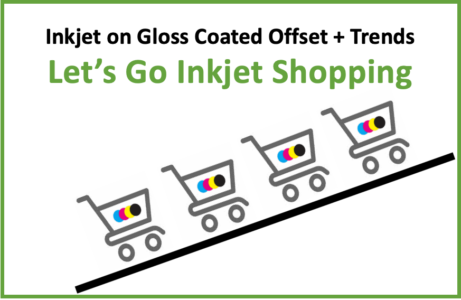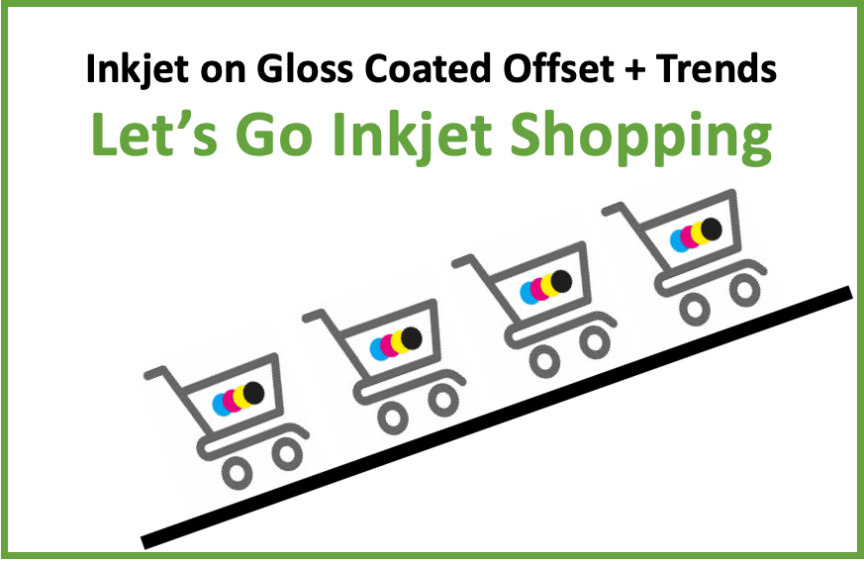The great news about inkjet is that there are more options available than ever. The bad news is it can be hard to keep up with the new capabilities. The first two articles in this series covered specific devices suited to entry-level buyers and ultra-high volume “big rigs” respectively, but there are a lot of interesting trends in the middle of the market. Here are a few to think about.
Inkjet on Offset Coated Stock is Here to Stick
OEMs are finding new and ingenious ways to delivery high quality on more substrates, including gloss coated offset.
- Canon has done this with hybrid aqueous ink and ColorGrip on their next generation VarioPrint and ProStream models.
- Fujifilm’s latest J Press 750S, B2 sheet-fed (simplex) press uses Fujifilm VIVIDIA aqueous pigment ink and RAPIC (Rapid Pigment Coagulation) primer to extend the color gamut beyond offset.
- The RICOH Pro VC70000 and Screen’s Truepress Jet520HD+ are delivering impressive results on offset coated, without the use of precoating, based on ink formulation, drying and other inkjet magic. This device also made it onto our list in the maximum productivity segment. It’s sibling, the Pro VC60000 will also print on coated gloss, but at lower speed and supporting lower ink coverage.
- The Komori Impremia IS29 and Konica Minolta AccurioJet KM1 can support an even wider range of substrates and weights due to the inherent nature of UV curable inks in a sheet-fed environment (rolls limit substrate thickness.)
- Landa has redefined the concept of inkjet with their heated blanket transfer process. Komori will be delivering the Komori Impremia NS40 based on this technology in 2020.
If you are looking for media flexibility, running costs of these different options can vary significantly. Make sure to understand the process that is being used to deliver the flexibility you crave.
Hybrid and DIY Inkjet Printing is Going Mainstream
Hybrid printing options are becoming more mainstream. There are opportunities to customize offset presses, customize inkjet presses and build complete solutions from the best that each OEM has to offer. The range of OEM solutions on the market is impressive, but if there is something you need for your business, consider talking to an integrator. If you don’t have the appetite for a completely customized solution, at least make sure to examine all of the configurable options from your inkjet OEM for commercially-available models such as ink (pigment or dye), drying and finishing.
Don’t Forget the Software
Software is a key component of efficient inkjet worfklow. Buying from the OEM may be the best option, but it pays to shop around. Most software types offered as part of a device proposal are also available from 3rd parties. Understand your options. As faster and more productive inkjet devices reach the market, maximizing productive uptime is truly essential. Investing in software and workflow design before buying a new press is highly recommended. That way you won’t waste a minute once that new machine hits the shop floor. Want to know what a minute costs? See our Essential Software Business Case Calculator.
The focus of this article was on devices and OEMs you can expect to meet at upcoming trade events, but there are many other solutions covered here on Inkjet Insight. Search the site, take a look at Device Finder and do some research before you hit the show floor. Get in touch if you need help finding the right solution or getting what you have running at top performance.
Now that you made it to the end of the article – here’s a prize. You can ATTEND PRINTING UNITED FOR FREE as a guest of Inkjet Insight using the VIP code: 6000000T. If you appreciate the great information and free stuff we provide, please take a moment to register as a free or contributing member of our community.


